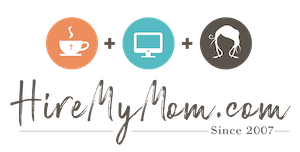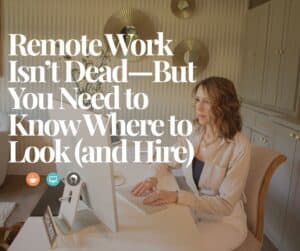Top Remote Roles in 2025 (and Where to Find or Fill Them)

Remote work is thriving in 2025—and it’s here to stay. As businesses continue to embrace flexibility, a growing number of skilled professionals are seeking remote opportunities that offer both autonomy and purpose. Whether you’re a small business owner looking to hire or a job seeker exploring your next opportunity, knowing the top remote jobs in 2025 can help you stay competitive.
In this guide, we explore the most in-demand remote roles this year and where you can go to find or fill them.
Why Remote Hiring Is on the Rise
According to a 2025 report from McKinsey, over 60% of companies now have a hybrid or fully remote workforce. Small businesses, in particular, benefit from hiring remote professionals due to:
- Reduced overhead costs
- Access to a wider talent pool
- Increased productivity and flexibility
This shift has also opened doors for professionals seeking better work-life balance, especially working parents, freelancers, and digital creatives.
Top Remote Jobs in 2025 for Small Businesses and Freelancers
1. Virtual Assistant (VA)
Still one of the most versatile and high-demand roles. VAs can handle:
- Inbox and calendar management
- Travel arrangements
- Customer support
- Social media scheduling
Perfect for: Time-strapped entrepreneurs and admin-savvy professionals.
Where to find or fill: HireMyMom.com Virtual Assistant Jobs
2. Social Media Manager
With platforms constantly evolving, social media pros are needed to:
- Plan and schedule content
- Engage with followers
- Monitor analytics and trends
Perfect for: Creatives with digital marketing skills and an eye for design.
Find a Social Media Manager or if you are looking for a social media job, Apply Today.
3. Content Writer / Copywriter
Content continues to dominate digital marketing. Skilled writers are hired for:
- Blog posts and newsletters
- Website and landing page copy
- Product descriptions
Perfect for: Writers with a flair for storytelling and SEO.
4. Online Customer Service Representative
Customers expect fast, friendly online support. CSRs provide help through:
- Email and chat
- CRM tools like Zendesk or HubSpot
- Knowledge base management
Perfect for: Detail-oriented communicators who enjoy solving problems.
Tip: Include software proficiency in your job description or resume.
5. Bookkeeper / Accounting
Even small businesses need help keeping their finances organized. Remote bookkeepers and accountants handle:
- Invoicing and payments
- Expense tracking
- QuickBooks or similar software
Perfect for: Professionals with accounting knowledge and strong organizational skills.
→ Hire a Remote Bookkeeper or Apply for Financial Roles
6. Email Marketing Specialist
Email marketing continues to deliver high ROI for small businesses. These professionals:
- Write and design email campaigns
- Manage subscriber lists
- Analyze open/click rates
Perfect for: Strategists with a mix of writing, design, and data skills.
Internal Link: Post or Apply for Email Marketing Jobs
How to Hire or Get Hired for These Roles
Whether you’re a business owner or freelancer, you need the right platform. General freelance sites often lead to:
- Unqualified applicants
- Time-consuming vetting
- High fees and inconsistent experiences
That’s why HireMyMom.com was created—to connect small businesses with experienced, U.S.-based remote professionals who are reliable, values-driven, and ready to work.
“Hire My Mom was exactly what I needed. As a stay-at-home mom looking for flexible, part-time remote work, I was overwhelmed by all the remote job listings and freelance sites – some of which felt a little scammy – and all of which took a lot of time. Hire My Mom felt different—personal, trustworthy, and full of real, vetted opportunities.
Within just a few days using the platform, I landed a job I was genuinely excited about. Now I get to use my skills, grow professionally, and still have the flexibility to be present for my family. I’m so grateful for this platform and highly recommend it to anyone looking for remote work that actually fits your life.”
— Jessica P.
Post Your Job or Get Matched Through Our Concierge Service
FAQ: Remote Job Trends in 2025
What is the most in-demand remote job in 2025?
Virtual assistants, social media managers, project / account managers, and customer service reps continue to top the list for small businesses.
Where can I find remote jobs that are flexible?
HireMyMom.com offers vetted, flexible job listings for part-time, project-based, and long-term roles.
Can I hire someone part-time or on a freelance basis?
Yes! Our platform is ideal for small businesses looking for flexible hiring options.
What industries are hiring remotely in 2025?
Popular industries include marketing, finance, e-commerce, coaching, tech, and health services.
Final Thoughts: The Remote Work Revolution Is Here
Remote work isn’t just a trend—it’s a strategic advantage for small businesses and an opportunity for professionals seeking freedom and flexibility. If you want to fill one of the top remote jobs in 2025 or get hired for one, make sure you’re using a platform that understands your needs.
Post Your Job Today or Create Your Profile and Apply to join the trusted network of HireMyMom.com.
Stay Connected
Want weekly tips on remote hiring and job search strategies?
Sign up for our newsletter and get our free “Complete Remote Hiring Guide”, job alerts, our free “How to Get Hired Guide” guide, and productivity tools straight to your inbox.









